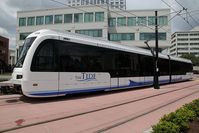A $1.50 fare isn’t holding back the Tide
Norfolk’s Tide Light Rail opened in 2011, and has exceeded its initial ridership projections. But the Virginian-Pilot newspaper recently called for Hampton Roads Transit to slash Tide fares to increase ridership. Are fares holding back ridership, or are other factors at play here?
Local media jumped on the news trying to figure out
Do free fares encourage new ridership?
Simply put, yes. The editorial notes that for a 10% decrease in fares, ridership generally increases about 3%. The real question is whether the additional subsidy required to operate a free (or cheap) transit service is worth the cost.
But for all of its problems, it’s probably not the fares that are keeping people from riding the Tide.
The Virginian-Pilot argues that the Tide’s problem is low demand, and points to falling ridership on the line. This ignores that ridership has fallen on the area’s bus routes as well, and in Hampton Roads a bus fare is the same as the fare on the Tide. Maybe the whole system should be free. That would probably increase transit ridership.
Other cities either have (or have experimented with) free fares but there’s not a lot of evidence that the prospect of a free ride leads to a big increase in ridership. Besides, there may be better ways to increase ridership.
What does the Tide actually need?
The editorial does make some suggestions that would also benefit the Tide. The first is an acknowledgement that the system needs to grow. Norfolk wants to expand the system within its own borders to the Naval Base and the Airport. Meanwhile Virginia Beach wants to take advantage of the existing railroad right of way and extend the line all the way to the Atlantic waterfront.
This would automatically put the system closer to a great number of people and jobs, and could even have state-wide benefits with the ability to take Amtrak to Norfolk and then light rail to the beach.
The editorial also notes that the Tide was meant to jumpstart a wave of transit-oriented development (TOD) that hasn’t happened yet. In the DC area we know how long it can take TOD to arrive even for an extensive system like Metro. The Pilot does seem to get that TOD will increase ridership. But instead of arguing for zoning and policy changes, it assumes the free fare itself will be enough to generate the TOD.
Development centered around transit will very likely increase ridership, though those land use changes will take decades. And people will not decide just to locate next to a transit line because it’s free or cheap. They’ll only move there if they find the line useful. If it doesn’t go where they’re going, they won’t ride it, even if it is free.
That’s why it’s important for Hampton Roads Transit to build a larger transit network and why it’s important for the local governments to encourage development (the places people want to go) near transit.
The city of Norfolk’s goal (building TOD and reducing traffic) is notably different from Hampton Roads Transit’s, whose goal is to make sure it can provide service without running into any large budget problems. If Norfolk ends up agreeing with the newspaper and makes the Tide free, maybe the city can pay the difference so the additional subsidy requirement won’t harm other transit services in the region.
It’s good that the Virginian-Pilot wants the Tide to be successful and recognizes that transit is an effective way to reduce or mitigate the effects of traffic congestion and how it can be a tool that allows lifestyle and urban form changes. But just focusing on fares is a narrow solution that will have less impact than a more balanced approach.
The same can be said for transit in the DC region. Free fares may be a good thing to consider, but we should be considering many factors when discussing how to increase ridership.
Projects like the Columbia Pike Streetcar will have ridership whether or not the cost to ride is free. The proposed line will connect dense, diverse neighborhoods along the Pike to the Pentagon and the Metro system. It will also likely encourage more development in the corridor over time, which will have a positive impact on ridership. Making fares cheaper may increase ridership, but transit-oriented development and service improvements (faster trips, more frequent trains) will make the line more useful, and that will have a much larger impact on ridership.

